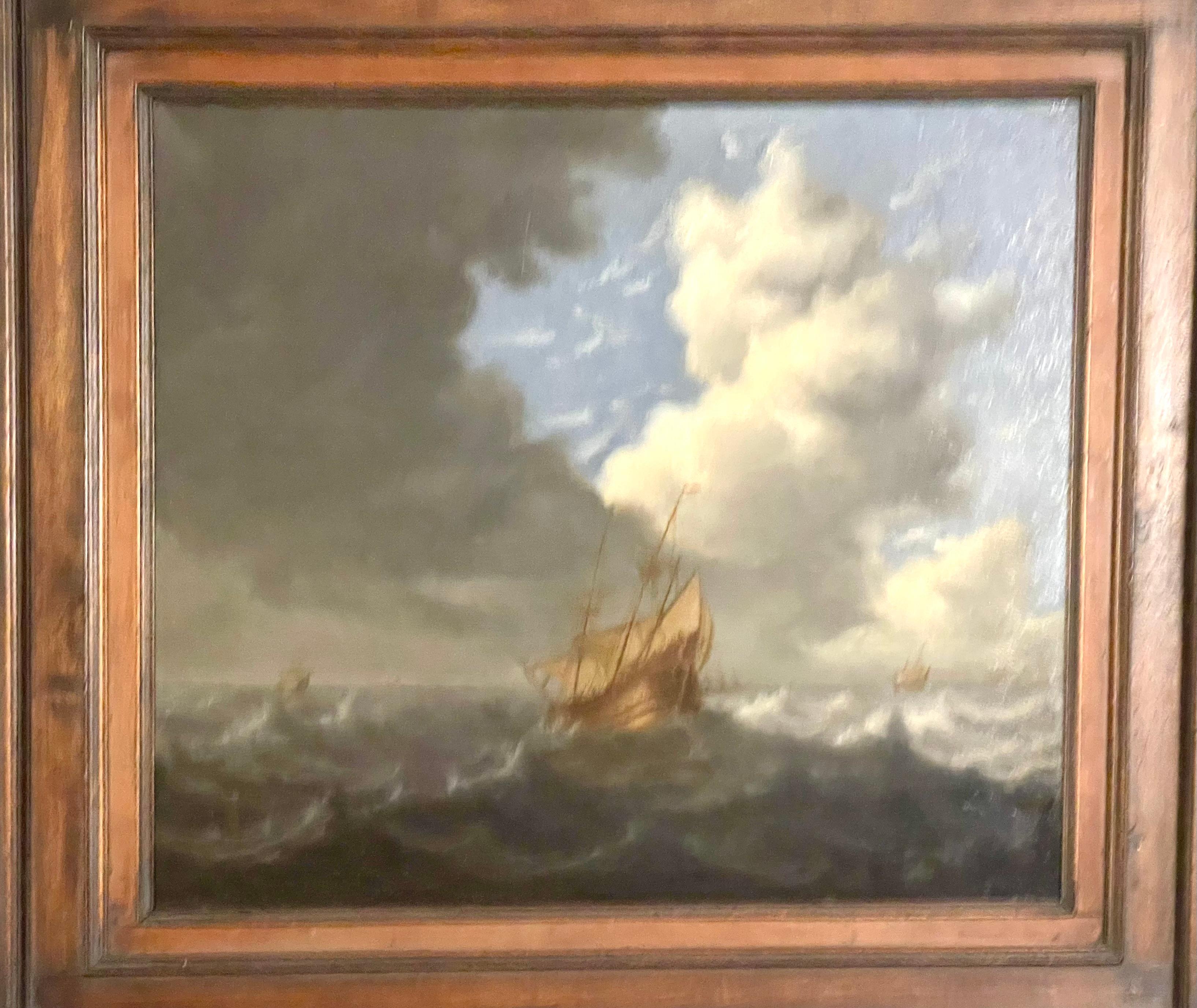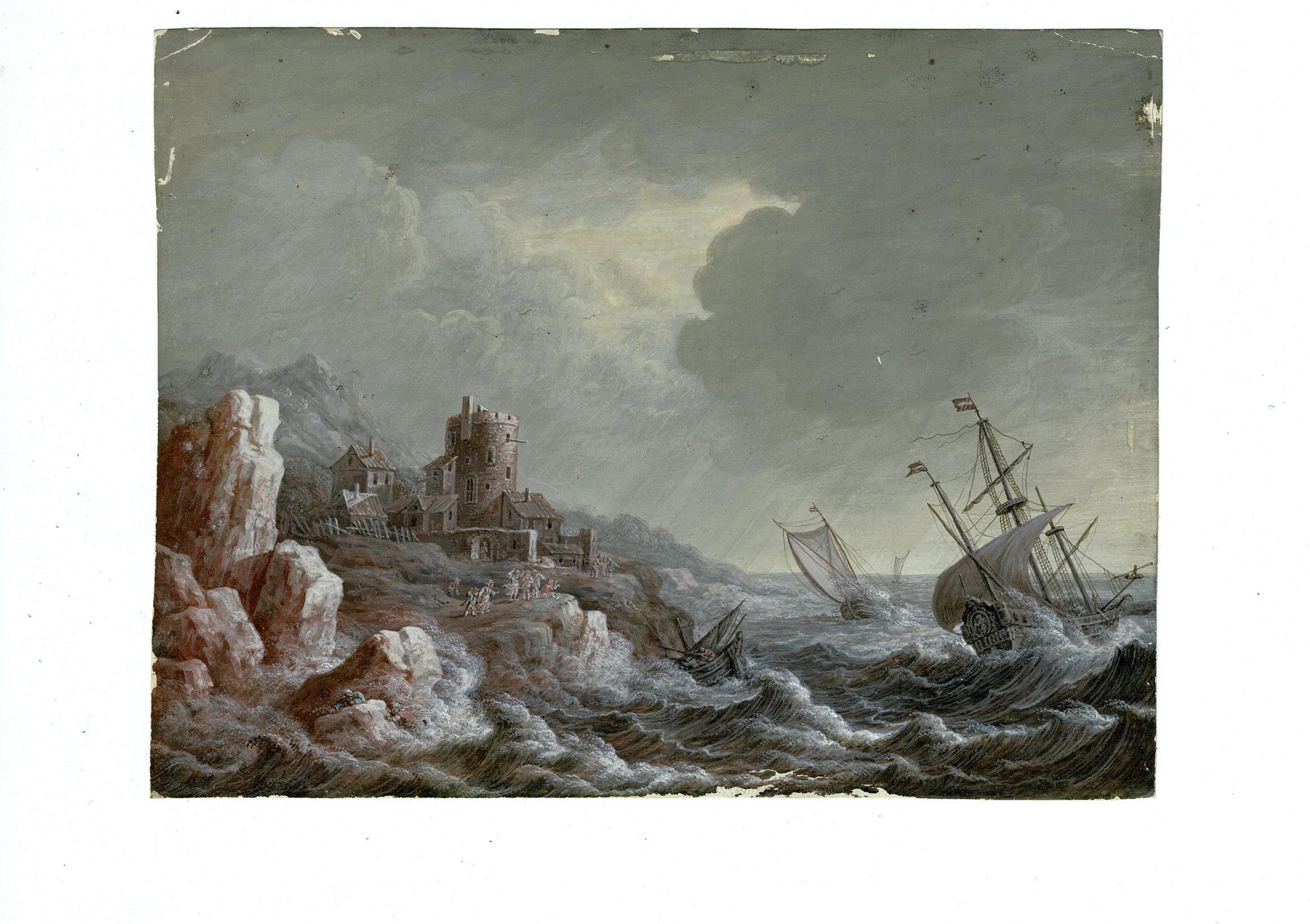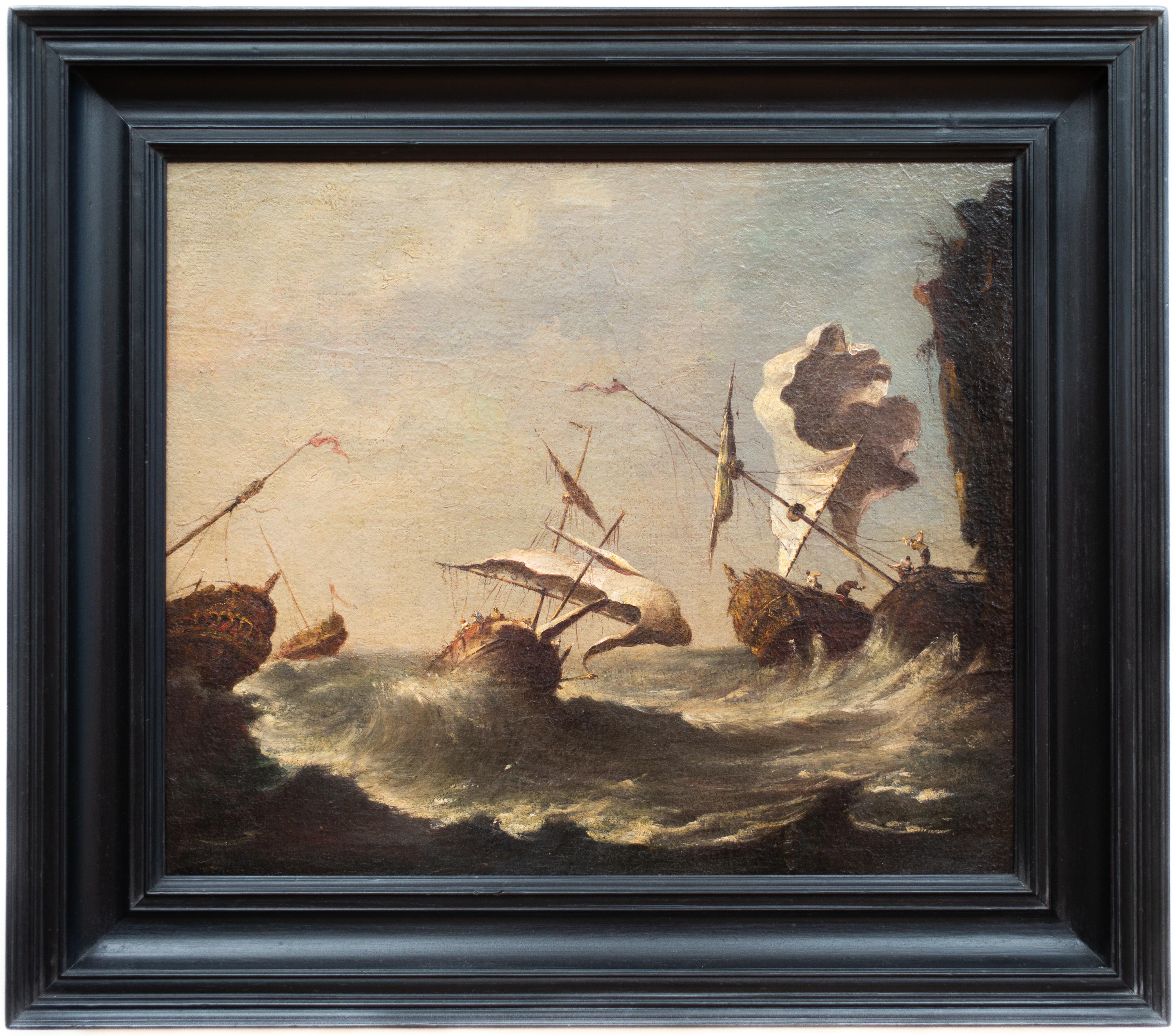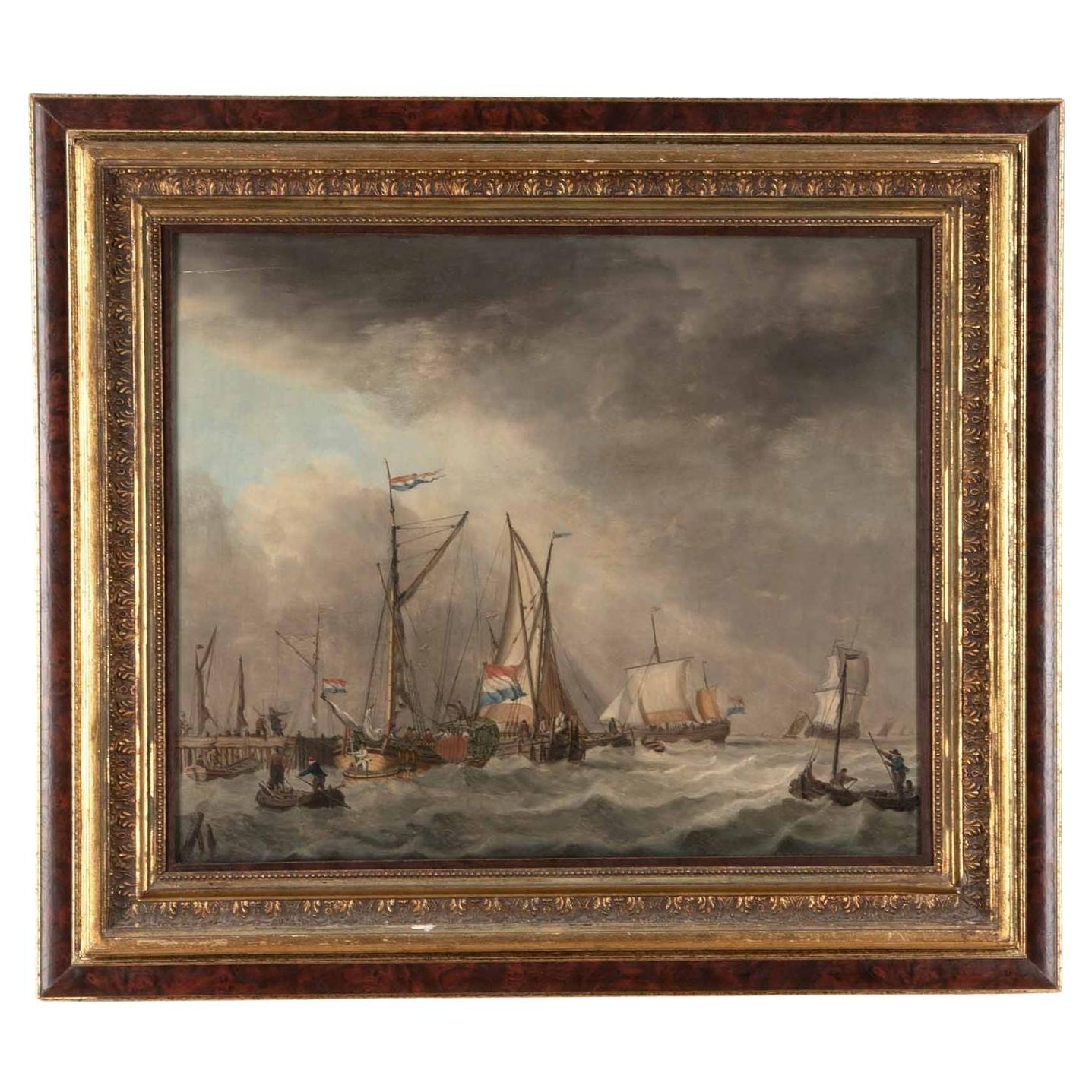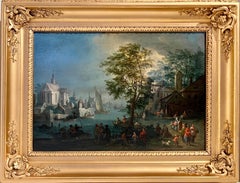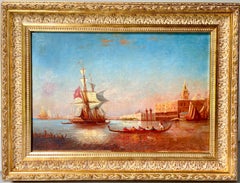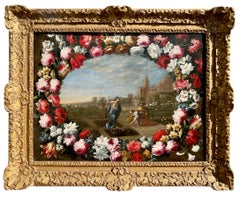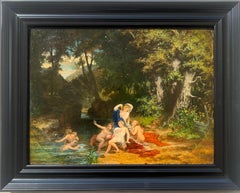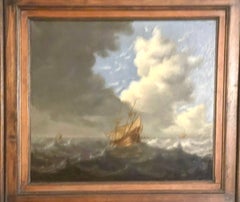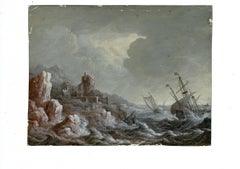Items Similar to 17th century Flemish seascape - Stormy Sea with Merchant Vessels and dolphins
Video Loading
Want more images or videos?
Request additional images or videos from the seller
1 of 19
Bonaventura Peeters the Elder17th century Flemish seascape - Stormy Sea with Merchant Vessels and dolphins
$7,787.93
£5,796.54
€6,500
CA$10,667.52
A$11,864.61
CHF 6,195.33
MX$144,379.72
NOK 79,123.84
SEK 74,204.21
DKK 49,482.23
Shipping
Retrieving quote...The 1stDibs Promise:
Authenticity Guarantee,
Money-Back Guarantee,
24-Hour Cancellation
About the Item
Bonaventura Peeters the Elder (1614–1652) attr., Stormy Coastal Scene with Merchant Vessels, Galliot, and Dolphins
Framed by rugged cliffs and illuminated under a dark, swirling sky charged with energy and atmosphere, a convoy of ships navigates the churning waves, an allegory of human resilience and strength. The ships press forward through chaotic seas, embodying the 17th-century maritime spirit of perseverance, trade, and exploration. This was a world in which the sea was both pathway and peril, and few artists conveyed its power with such precision and poetic force as Peeters.
At center, a three-masted Dutch merchantman, likely a fluyt, braves the crashing waves with sails full and national ensign unfurled, sailing headlong into the storm. Cannons can be seen on proud display. To the right, a smaller galliot or coastal trader, distinguished by its reddish-brown sail, clings closer to the rocky shoreline. Other vessels emerge through the mist in the distance, hinting at a larger convoy navigating the dangers of open water.
A delightful naturalistic touch lies in the school of dolphins leaping just beneath the main vessel, a sign of life within the tempest and a testament to Peeters’ deep observation of the maritime world.
The artist’s technical mastery is especially evident in the rendering of foliage along the rocky outcrop at right, where he scratched directly into wet paint using the reverse end of his brush; a gesture that speaks to his confidence and painterly bravura. Just below this area, a faint monogram "BP" appears to be visible on the rock face, a subtle but meaningful mark of authorship.
Artist Biography
Born in Antwerp in 1614, Bonaventura Peeters I is regarded as one of the most influential figures in early Flemish marine painting. Active in Hoboken and later in Brussels, he helped define a genre that merged detailed nautical knowledge with the drama and grandeur of the Baroque.
Peeters excelled in capturing the psychological intensity of the sea, portraying it as both sublime and threatening. His works combined meticulously observed ships, masterful sky and water studies, and an emotional weight rare among his contemporaries. Though he died young in 1652, his legacy shaped the direction of marine art for decades.
His paintings can be found in prestigious museum collections, including:
Royal Museums of Fine Arts of Belgium, Brussels
National Maritime Museum, Greenwich
Musée des Beaux-Arts, Rouen
Rijksmuseum, Amsterdam
Provenance:
Kunsthaus am Museum, Cologne, June 11–14, 1980 (lot 1215). With a “Gutachten” (expertise) issued by Walther Bernt, 1969.
German Private Collection
Dimensions:
Oil on panel ca. 41 by 70,5 cms with frame ca. 85 by 55.5 cms
- Creator:Bonaventura Peeters the Elder (1614 - 1652, Flemish)
- Dimensions:Height: 16.15 in (41 cm)Width: 27.76 in (70.5 cm)
- Medium:
- Movement & Style:
- Period:
- Framing:Frame IncludedFraming Options Available
- Condition:Lovely. Recently cleaned and ready to hang.
- Gallery Location:Aartselaar, BE
- Reference Number:1stDibs: LU1423216694502
About the Seller
5.0
Vetted Professional Seller
Every seller passes strict standards for authenticity and reliability
Established in 2020
1stDibs seller since 2020
375 sales on 1stDibs
Typical response time: 1 hour
- ShippingRetrieving quote...Shipping from: Aartselaar, Belgium
- Return Policy
Authenticity Guarantee
In the unlikely event there’s an issue with an item’s authenticity, contact us within 1 year for a full refund. DetailsMoney-Back Guarantee
If your item is not as described, is damaged in transit, or does not arrive, contact us within 7 days for a full refund. Details24-Hour Cancellation
You have a 24-hour grace period in which to reconsider your purchase, with no questions asked.Vetted Professional Sellers
Our world-class sellers must adhere to strict standards for service and quality, maintaining the integrity of our listings.Price-Match Guarantee
If you find that a seller listed the same item for a lower price elsewhere, we’ll match it.Trusted Global Delivery
Our best-in-class carrier network provides specialized shipping options worldwide, including custom delivery.More From This Seller
View AllBustling 17th century harbour landscape with fishermen, visitors and merchants
By Mathys Schoevaerdts
Located in Aartselaar, BE
17th Century Flemish Painting "A bustling scene of fishermen, merchants and visitors in a peaceful and picturesque port village”
This intriguing painting offers a wonderful and real...
Category
17th Century Old Masters Landscape Paintings
Materials
Oil, Canvas
19th century romantic French painting - View of Venice - Ziem San Marco
Located in Aartselaar, BE
Lovely 19th century romantic cityscape painting of Venice
With vibrant colors and swift brushstrokes, the artist of the present painting wonderfully captured a large boat departing ...
Category
19th Century Impressionist Figurative Paintings
Materials
Canvas, Oil
Large 17th century Italian old master - Noli me tangere, Christ in the garden
By Pier Francesco Cittadini
Located in Aartselaar, BE
Large 17th Century Italian Old Master, The Garden - Noli me tangere, Pier Francesco Cittadini (attr.)
Description
In the stillness of a garden in bloom, Noli me tangere captures a p...
Category
17th Century Old Masters Figurative Paintings
Materials
Canvas, Oil
19th century French Barbizon school painting Elegant group outdoors
By Jules Coignet
Located in Aartselaar, BE
19th century Barbizon painting "The nymphs bathing in a forest landscape"
The artist wonderfully captured this dreamy scenery with vibrant colours and assured brushstrokes, inviting...
Category
19th Century Impressionist Figurative Paintings
Materials
Panel, Oil
19th century romantic oil - Loving horses in a countryside hay harvest landscape
By Henry Schouten
Located in Aartselaar, BE
"Loving horses in a countryside hay harvest landscape" signed P. Laruche, which appears to be a pseudonym used by Henry Schouten
This peaceful painting two loving horses in a sun-li...
Category
19th Century Romantic Animal Paintings
Materials
Oil, Canvas
Sunrise above the sea port - Scandinavian pointillism painting - Early 1900s
Located in Aartselaar, BE
Stunning Scandinavian Impressionist painting depicting a glorious sunrise above the port of Goteborg in Sweden
The artist marvellously captured the way in which the light of the ris...
Category
20th Century Pointillist Landscape Paintings
Materials
Canvas, Oil
You May Also Like
Dutch ships on rough seas 17th Century
Located in Hillsborough, NC
Dutch School, 17th century oil painting on board, this work features a golden ship on blue seas with white crests against a stormy clouded sky. In the distance more ships can be seen, and a spot of blue sky gives the stormy clouds relief. Light shines through the white clouds casting shadows of color on the gray storm and choppy sea waters. Dramatic and masterful.
Presented in overall very good condition in what may be the original mahogany wood frame.
Excellent for an office, library, den or study, but can also be effective in a living room, dining room or bedroom.
The frame has a rich wood tone. Easy to ship and ready to hang.
Check out our Saltire Gallerie...
Category
17th Century Dutch School Landscape Paintings
Materials
Oil, Board
$2,560 Sale Price
20% Off
Seascape Ships Landscape Porcellis 17th Century Paint Oil on table Old master
Located in Riva del Garda, IT
Julius Porcellis (Rotterdam 1610 – 1645 Leiden) attributable
Seascape with ships
Oil on wood panel (oak) 52 x 84 cm In gilded wood frame 77 x 108 cm
The painting on display d...
Category
17th Century Old Masters Paintings
Materials
Oil
$8,473 Sale Price
20% Off
Dutch School, Marine, Coastal Scene with Ships in Storm
Located in Greven, DE
Marine
Dutch School, 18th Century
Coastal Scene with ships in a storm
Gouache on prepared paper
Category
18th Century Baroque Landscape Drawings and Watercolors
Materials
Gouache
Large 18th Century Oil Painting Marine Seascape of British Navy Fleet off Dover
By Dominic Serres
Located in Gerrards Cross, GB
‘The British Fleet with a Vice-Admiral of the Red off Dover’ by Dominic Serres R.A. (1722-1793).
French-born Dominic Serres didn’t just paint the drama of...
Category
Late 18th Century English School Landscape Paintings
Materials
Oil
Shipping in Stormy Waters, Attributed to Italian Artist Francesco Guardi
By Francesco Guardi
Located in Stockholm, SE
The splendour of the tragic sea
Francesco Guardi and maritime painting in Venetian art
No Venetian painter was a stranger to the sea. After all, Venice was not only one of the most prominent ports of the Mediterranean, but indeed a city literally submerged in the ocean from time to time. Curiously however, the famous Venetian school of painting showed little interest in maritime motifs, favouring scenes from the iconic architecture of the city rather than seascapes. That is why this painting is a particularly interesting window into not only the painter Francesco Guardi himself – but to the significance of the element of water in art history, in absence as well as in the centre of attention.
Whether it be calm, sunny days with stunning views of the palaces alongside the canals of Venice or – more rarely – stormy shipwrecking tragedies at sea, water as a unifying element is integral to the works of painter Francesco Guardi (1712–1793). During his lifetime, Venetian art saw many of its greatest triumphs with names like Tiepolo or Canaletto gaining international recognition and firmly establishing Venice as one of the most vibrant artistic communities of Europe. While the city itself already in the 18th century was something of an early tourist spot where aristocrats and high society visited on their grand tour or travels, the artists too contributed to the fame and their work spread the image of Venice as the city of romance and leisure to an international audience, many of whom could never visit in person.
Still today, the iconic image of Venice with its whimsical array of palaces, churches and other historic buildings is much influenced by these artists, many of whom have stood the test of time like very well and remain some of the most beloved in all of art history. It was not primarily subtility, intellectual meanings or moral ideals that the Venetian art tried to capture; instead it was the sheer vibrancy of life and the fast-paced city with crumbling palaces and festive people that made this atmosphere so special. Of course, Venice could count painters in most genres among its residents, from portraiture to religious motifs, history painting and much else. Still, it is the Vedutas and views of the city that seems to have etched itself into our memory more than anything else, not least in the tradition of Canaletto who was perhaps the undisputed master of all Venetian painters.
Born into his profession, Francesco lived and breathed painting all his life. His father, the painter Domenico Guardi (1678–1716) died when Francesco was just a small child, yet both he and his brothers Niccolò and Gian Antonio continued in their fathers’ footsteps. The Guardi family belonged to the nobility and originated from the mountainous area of Trentino, not far from the Alps. The brothers worked together on more challenging commissions and supported each other in the manner typical of family workshops or networks of artists. Their sister Maria Cecilia married no other than the artist Giovanni Battista Tiepolo himself, linking the family to the most renowned Venetian name of the time. During almost a decade, Guardi worked in the studio of Michele Giovanni Marieschi, sometimes simply known as Michiel, a painted similar in both style and motif. Canaletto is, however, the artist Guardi is most often compared to since they shared a mutual fascination for depicting the architecture and cityscape of Venice.
During the course of his career, Guardi tried his hand in many different genres. He was as swift in painting landscapes, Vedutas of Venice, sacred motifs, interiors and architectural compositions as he was in a number of other motifs. His style is typical of the Venetian school but also distinct and personal once we look a little closer. There is an absolute certainty in the composition, the choice of which sometimes feels like that of a carefully calculated photograph – yet it is also very painterly, in the best sense of the word: fluid, bold, sensitive and full of character. The brushwork is rapid, intense, seemingly careless and extraordinarily minute at the same time; fresh and planned in a very enjoyable mixture. His interiors often capture the breath-taking spacious glamour of the palaces and all their exquisite decor. He usually constructed the motif through remarkably simple, almost spontaneous yet intuitively precise strokes and shapes. The result was a festive, high-spirited atmospheric quality, far away from the sterile and exact likeness that other painters fell victim to when trying to copy Canaletto.
The painting here has nothing of the city of Venice in it. On the contrary, we seem to be transported far away into the solitary ocean, with no architecture, nothing to hold on to – only the roaring sea and the dangerous cliffs upon which the ships are just moments away from being crushed upon. It is a maritime composition evoking both Flemish and Italian precursors, in the proud tradition of maritime painting that for centuries formed a crucial part of our visual culture.
This genre of painting is today curiously overlooked, compared to how esteemed and meaningful it was when our relationship to the sea was far more natural than it is today. When both people and goods travelled by water, and many nations and cities – Venice among them – depended entirely on sea fare, the existential connection to the ocean was much more natural and integrated into the imagination. The schools and traditions of maritime art are as manifold as there are countries connected to the sea, and all reflect the need to process the dangers and wonders of the ocean.
It could symbolize opportunity, the exciting prospects of a new countries and adventures, prospering trade, beautiful scenery as well as war and tragedy, loss of life, danger and doom. To say that water is ambivalent in nature is an understatement, and these many layers were something that artists explored in the most wondrous ways. Perhaps it takes a bit more time for the modern eye to identify the different nuances and qualities of historic maritime paintings, they may on first impression seem hard to differentiate from each other. But when allowing these motifs to unfold and tell stories of the sea in both fiction and reality – or somewhere in between – we are awarded with an understanding of how the oceans truly built our world.
In Guardi’s interpretation, we see an almost theatrically arranged shipwrecking scene. No less than five ships are depicted right in the moment of utter disaster. Caught in a violent storm, the waves have driven them to a shore of sharp cliffs and if not swallowed by the waves, crushing against the cliffs seems to be the only outcome. The large wooden ships are impressively decorated with elaborate sculpture, and in fact relics already during Guardi’s lifetime. They are in fact typical of Dutch and Flemish 17th century ships, giving us a clue to where he got the inspiration from. Guardi must have seen examples of Flemish maritime art, that made him curious about these particular motifs. One is reminded of Flemish painters like Willem van de Velde and Ludolf Backhuysen, and this very painting has indeed been mistakenly attributed to Matthieu van Plattenberg...
Category
18th Century Old Masters Landscape Paintings
Materials
Canvas, Oil
$47,805 Sale Price
32% Off
Free Shipping
18th Century Dutch Seascape Painting by Jan Verbruggen
Located in Gloucestershire, GB
18th Century Dutch harbour scene / seascape painting with ships in stormy waters by Jan Verbruggen (1712-1780).
Signed 'J.Verbruggen'. Jan Verbruggen and his son Peter were artists,...
Category
Antique Mid-18th Century Dutch Baroque Paintings
Materials
Canvas, Paint
